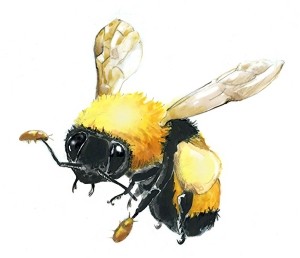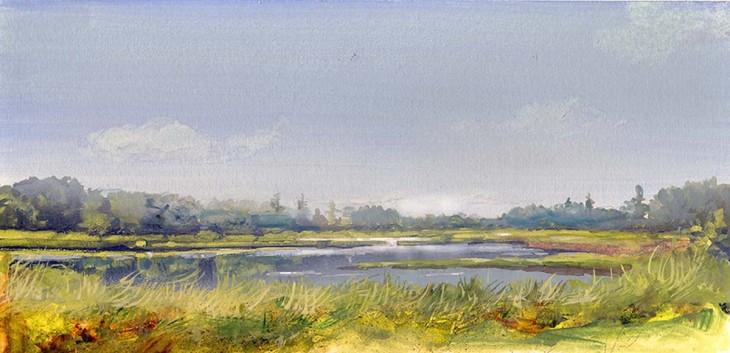
While I was photographing pollinators on a patch of meadow near a bike path, a bumblebee caught my attention. It appeared to have an enormous, clubbed antenna, as well as a normal-size one. Closer inspection revealed that the clubbed antenna was in fact the same size as the other, but sporting a small tan beetle.
Beetles in the genus Antherophagus live in bumblebee nests, where they dine innocuously on detritus left by their hosts. Despite the benefits (stinger-equipped guards and access to a self-replenishing food source), living on bumblebee leavings is easier said than done. The main obstacle the beetles must overcome is finding a bumblebee nest.
If the beetles depended on European honeybees, this problem would be trivial because healthy honeybee colonies persist for many years. The beetles could feed, grow to adulthood, and lay their eggs in one hive. Small hive beetles (Aethina tumida) recently imported from Africa do exactly that. But bumblebee colonies die off every autumn, leaving only young queens that burrow into the ground, emerge the next spring, and fly away to build new nests. Antherophagus beetles must therefore relocate annually.
The best way to find a bumblebee nest is to find a bumblebee. And so each summer, adult beetles seek out locations most likely to be frequented by bumblebees. They hang out in flowers, and when a bumblebee lands in search of nectar, the beetle clamps on with its jaws and hitches what is literally the one and only ride of its life.
When animals use other animals as transport, it is called phoresis. There are many examples including mites on carrion beetles, feather lice riding flies to new hosts, mussel larvae on the gills of yellow perch, and people on camels and horses. In the case of these beetles, hitchhiking gets them to their destination, which is the end of their journey, but not the end of their story.
Unless the same or a sister bumblebee (serving as an unwilling Uber driver) brings a second hitchhiker home, the beetle will have a solo existence. But once a pair of beetles finds themselves in a bumblebee nest, they mate, lay eggs – and along with their larvae – consume bee waste happily ever after, with no apparent negative impact on the bees.
Although Antherophagus may be a model house guest, the beetle’s means of transportation is not something any bee would willingly choose. The bee I observed was working frantically and unsuccessfully to remove the beetle between foraging bouts. The effort certainly reduced foraging success that day. Others have observed these beetles clamped onto bee’s legs. In one case, a beetle gripped a bee’s proboscis and while trying to remove the beetle, the bee tumbled into the surrounding vegetation. On a human scale this would be comparable to something the size of a gray squirrel refusing to let go of your tongue.
As unlikely as this beetle-bee relationship may appear, it is not the only bee-beetle hitchhiker association, and certainly not the most bizarre. The larvae of a certain California blister beetle (Meloe franciscanus) gather and assemble to roughly mimic the shape, appearance, and even the scent of female burrowing bees; and “roughly” is more than enough to do the job.
When an amorous male bee approaches the “female,” he suddenly experiences a flash-mob of louse-like larvae that clamber onto him, hold on tightly with three-clawed feet, and hitch a mass-transit ride. Undeterred by his uninvited passengers and ever the romantic, the bee continues his quest for a more suitable mate. The larvae then “change horses” and ride the female back to her nest. The larvae of Meloe impressus, a native northeastern blister beetle species, are not known to perform this mimicry trick, but their larvae will also attach themselves to passing bees.
Unlike the innocuous house guests mentioned above, Meloe larvae have more sinister intent. Once the female burrowing bee builds her nest, the disembarked blister beetle larvae feed on the bees’ eggs or larvae.
These spectacular contributions to the tapestry of life are possible only because habitat remains for bees and beetles to complete their life cycles. In the case of Antherophagus beetles and their bumblebee hosts, patches of pollinator habitat are essential. In Essex, Vermont, where I found my Antherophagus specimen, that habitat is sandwiched between a wetland and a bike path at the intersection of two busy roads.
This small patch of wetland and meadow provides the basics: food, water, and shelter. Large nature preserves and national forests are valuable and wonderful, but even small patches of native vegetation, either planted deliberately or allowed to grow in place of more manicured landscapes, can support biodiversity and attract a fascinating cast of characters … including bee-riding beetles!


